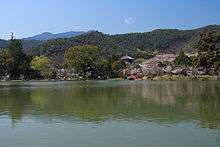Saga Go-ryū

Saga Go-ryū (嵯峨御流) is a school of ikebana, the Japanese traditional art of flower arrangement.
History
The history of the school goes back to Emperor Saga, who ruled from 809-823 CE during the Heian period. The emperor resided at a villa in Kyoto, and had a large pond with gardens arranged at it. This Ōsawa Pond is around 2.4 hectares large and is supposed to reflect the outlines of Dongting Lake in China, which has a special significance in Chinese culture. The style is known as chisen-shuyu, which is a garden meant to be seen from a boat, similar to the imperial Chinese gardens of the period. The lake was created by damming a stream which came from the Nakoso waterfall.
At the north end of the pond are two islands, one large and one small - the small island being known as Chrysanthemum Island. Between the two islands are several small rocky islets, meant to resemble Chinese junks at anchor. On a hillside north of the lake is what appears to be a dry cascade (karedaki), a kind of Japanese rock garden or zen garden, where a real waterfall is suggested by a composition of stones.
According to tradition the emperor had chrysanthemums blooming on an island of the pond arranged to be presented at court.[1] This is seen as the beginning of the Saga school of flower arrangement.

The garden was celebrated in the poetry of the period. A poem by Ki no Tomonori in the anthology Kokinshū, described the Kiku-shima, or island of chrysanthemums, found in the pond.
- I had thought that here
- only one chrysanthemum can grow.
- Who therefore has planted
- the other in the depths
- of the pond of Ōsawa?
Another poem of the Heian period, in the Hyakunin isshu, described a cascade of rocks, which simulated a waterfall, in the same garden:
- The cascade long ago
- ceased to roar,
- But we continue to hear
- The murmur
- of its name.[2]
The imperial villa was turned by Princess Masako, the daughter of Emperor Saga, into a Shingon Buddhist monastery named Daikaku-ji. The headquarters of the Saga school has been located there ever since.
The school has around 109 branches in Japan, and some 20 offices and branches in rest of the world.[3]
Styles
The styles have developed over the centuries and were formalised much later. The traditional styles are seika, heika, moribana, and shogonka. The more modern shinshoka style consists of inoribana, sainohana, and omoibana.[4]
Seika is the classical style based on the concepts of heaven, earth, and humans. It is viewed frontal and is placed in a tokonoma and is used for guests and ceremonies at home. Heika and moribana are the free styles. They are based on the natural beauty of the temple, and are used either as chabana flower decoration for tea ceremonies, or bunjinbana, the poetic expression of one's emotion. Shogonka is the festive and formal style, which developed out of the religious ceremonies and reflects the esoteric Rokudai philosophy. The newest style is shinshoka, which tries to demonstrate the basic essentials of Saga Goryū by using as little material as possible.
Stems are cut in water since it is believed that they hold longer that way, a method called mizu-kire. The school does not use the spiked kenzan flower holders, since it would be considered a form of unnecessary destruction to the plants, but shippo (七宝留めと), which are circular metal devices that fit into the vase or bowl and fix the stems by a number of holes that stems could be fit through for arranging.
References
- ↑ http://www.daikakuji.or.jp/english/ikebana/
- ↑ Nitschke, Le Jardin Japonais, pg. 42. Excerpts translated from French by DR Siefkin.
- ↑ http://www.ikebanahq.org/saga.php
- ↑ http://www.daikakuji.or.jp/english/ikebana/
External links
![]() Media related to Saga Go-ryū at Wikimedia Commons
Media related to Saga Go-ryū at Wikimedia Commons